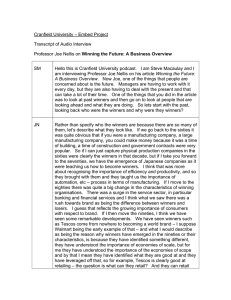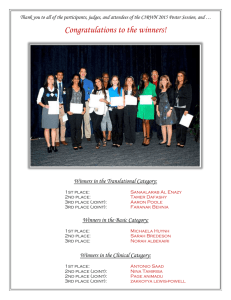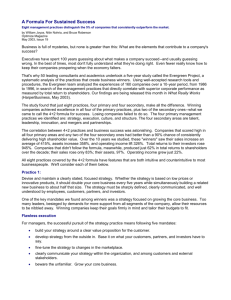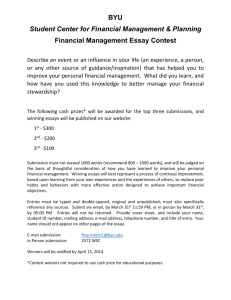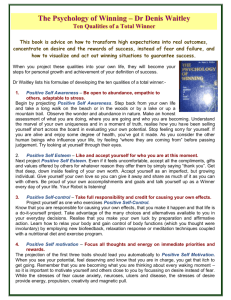The attached article was published in issue 146, the July/August 2007
advertisement
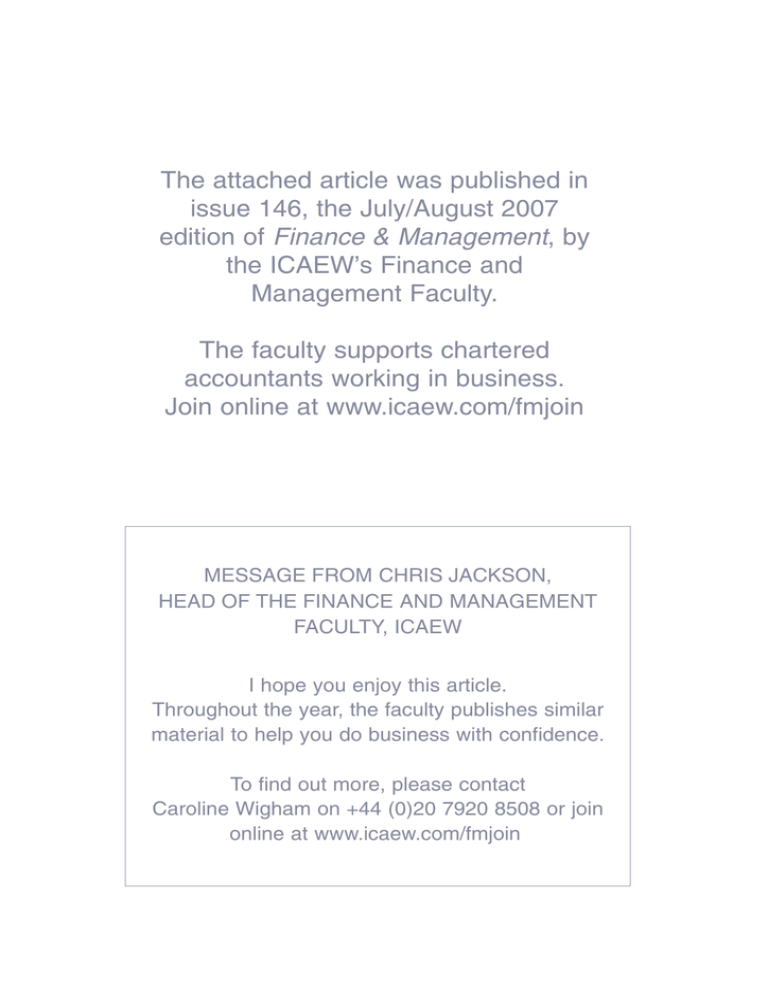
The attached article was published in issue 146, the July/August 2007 edition of Finance & Management, by the ICAEW’s Finance and Management Faculty. The faculty supports chartered accountants working in business. Join online at www.icaew.com/fmjoin MESSAGE FROM CHRIS JACKSON, HEAD OF THE FINANCE AND MANAGEMENT FACULTY, ICAEW I hope you enjoy this article. Throughout the year, the faculty publishes similar material to help you do business with confidence. To find out more, please contact Caroline Wigham on +44 (0)20 7920 8508 or join online at www.icaew.com/fmjoin FINANCE & MANAGEMENT ECONOMICS FINANCE & MANAGEMENT July/August 2007 ECONOMICS WINNING THE FUTURE – A BUSINESS OVERVIEW In his recent lecture to the Finance & Management Faculty, Joe Nellis identified which would be the winning business sectors of the future. Here he summarises his arguments. In considering what winning companies of the future might look like, it is useful to reflect on the past and, with the benefit of hindsight, identify some of the common features of winners in recent decades. Past winners Many winners in the 1960s were large scale manufacturing organisations, often with strong links to government through major contracts involving house building, road building, railways, hospitals, schools, etc. This was a ‘booming’ decade driven mainly by the rebuilding programmes of the post-war era. To some extent similar features can be found in winners in the 1970s, although this decade saw the arrival on the world scene of competitive Japanese firms, with a focus on economies of scale through automation, resulting in strong increases in productivity and efficiency. Moving on, the 1980s saw the emergence of the service sector as a driving force in many mature economies, with an emphasis on brand marketing and growth in market share. During the 1980s, particularly in the UK, there were also significant developments in the competitive environment as a result of extensive deregulation eg, the opening up of the UK financial services sector, giving rise to the so-called ‘Big Bang’ effect. In the 1990s the impact of technology – already a driving force in the corporate world for many years – showed explosive growth. Companies which surged ahead were those that successfully identified and embraced the opportunities offered by appropriate investments in new technologies, particularly those which enhanced customer service and which captured vital customer information. In tandem, some winning companies have been those which appreciated the implications of globalisation and responded accordingly, while other winners have been those that successfully leveraged off their core compe- The awakening of countries such as India and China has fundamentally changed the consumer landscape Finance & Management Faculty Joe Nellis is professor of international economics, Cranfield School of Management. j.g.nellis@cranfield.ac.uk tencies and identified the benefits of economies of scope (Tesco being one of the best examples). Drivers of change – the present In more recent years there has been unprecedented change in the business environment, nationally and internationally. The drivers of change have been many and may be categorised with respect to: ● global economic trends; ● social trends; and ● business trends. Global economic trends Global economic trends are those associated with developments such as the massive realignment of economic activity across the world, particularly from west to east. Combined with this we are seeing an unprecedented expansion in demand for public sector services in terms of the provision of health, education, defence, etc. The awakening of countries such as China and India has fundamentally changed the global consumer landscape. Consider, for example, the almost unimaginable demand for consumer durables of all types from these two nations alone as their economies emerge from the ‘base of the pyramid’ over the coming decades. Social trends With respect to social trends, we are now in a world where everyone is ‘connected’ as a result of the explosion of technology and telecommunications. This has profound implications for societies in every country, with new ‘virtual communities’ formed over the internet on a daily basis. With populations in the developed world ageing, and those in the developing world increasing in size, the battlefield for talent is heating up – currently, the developed world produces around 16m university graduates per year, compared with more than 33m from emerging and developing countries. Dynamics associated with globalisation have created a global pool of new, young, enthusiastic workers and consumers with implications for corporate governance as well as for the sustainability of natural resources (especially water and energy). Business trends Finally, business trends are reflecting the fact that there is now universal access to knowledge through search 5 July/August 2007 FINANCE & MANAGEMENT ECONOMICS engines such as Google and Wikipedia – so that virtually everyone now has unlimited knowledge at their fingertips, at any time and in any place. Alongside this development, new global industry structures are being formed through global alliances and networks. There is no escaping the fact that the world of business is now much more complex than ever before and this has put greater emphasis on the need for more technical managerial skills – it could be said that management is fast becoming more of a science than an art in today’s world! In this ‘new’ world order, what are some of the new realities facing business? The new business realities It is inevitable that many of the ‘old’ business models will die – along with many ‘old’ businesses. Survival and success crucially depend on identifying new business models and new ways of sustaining, growing and creating new profit streams. Consider, for example, the changes that have taken place in retail banking over the past decade, with the decline of the traditional branch network (an ‘old’ model) and the emergence of new customer channels such as internet and telephone banking (just two of the ‘new’ models). One challenge for management is to recognise when to change from the old to the new ways of doing business before it is too late. As competition becomes more open as a result of widespread deregulation, new and more dynamic competitors are emerging – while ‘old’ players continue to play by ‘old’ rules in terms of profit margins and business models, ‘new’ players are creating the ‘new’ rules. At the same time, the pace of innovation is accelerating, with the consequence that it will become more and more difficult for companies to sustain profitability on the basis of differentiation – since the learning curve and product life cycles are getting shorter and shorter. One could readily argue that quality is rapidly becoming a commodity in many sectors. For example, safety (as an indicator of quality) in airline travel is now something that everybody expects – who would board a plane if there was any doubt about its ability to land? So who would pay a premium price on the basis of safety alone? Safety can no longer, therefore, be marketed as a ‘quality differential’ between different airlines. Similarly, how FIGURE 1: NEW UNEXPLORED OPPORTUNITIES The existing battleground for market share Served 6 many of us would choose to buy a car that we knew would be unreliable? To a large extent, all cars today are ‘good quality’ (although with many different features) and so this creates a challenge for premium-priced car manufacturers, in terms of justifying the margin between their cars and those in the mass market. The consequence is that, increasingly, organisations are facing shorter periods of competitive advantage and, inevitably, tighter profit margins. Since the mid-1990s the UK has enjoyed an unprecedented period of steady growth. It seems that the business environment has never been more favourable! However, this cannot be taken for granted as a sustainable determinant of profitability – we have not yet managed to eradicate business cycles. At the same time, there is a danger in today’s world that improvement in organisational efficiency (ie, cutting costs) is seen as a means of maintaining profitability. Management must always remember that cutting costs is not, and must never be regarded as, the basis of sustainable competitive strategy. Future winners – blue ocean thinking and closing the ‘creative gap’ Ultimately, winners will be those companies that are able to ‘rewrite the rules’ of the game. Recognition of this will result in new business models, innovative thinking, greater creativity and, as encapsulated by Chan Kim and Reneé Mauborgne, a realisation that ‘competing in overcrowded industries is no way to sustain high performance’. This has given rise to the phenomenon they have popularly described in their book Blue Ocean Strategy, in which the real opportunity is to create ‘blue oceans of uncontested market space’. Figure 1, left, captures the essence of this approach to strategic thinking. The so-called ‘red ocean’ (the bottom left-hand quadrant) represents the existing battleground for market share in which existing needs expressed by customers are served by existing firms on the basis of current business models and products. The aim is to beat the competition and exploit existing demand. However, consider the scale of new unexploited opportunities if new needs can be created – needs which, by definition, are not currently being served. In other words, how much profit would companies make if they could create needs that do not yet exist? Needs created Needs expressed Winning organisations will be those that challenge accepted wisdoms Not served As one example of this type of thinking, remember that until the early 1990s the market for packaged, pre- Finance & Management Faculty FINANCE & MANAGEMENT July/August 2007 ECONOMICS/HBR washed salad was more or less zero – today this market is worth billions of dollars around the world. Somebody, somewhere, created this new market by offering customers convenience, albeit at a higher price. The explosion of low cost air travel is another example of how new needs have been created by new business models – with people even flying to other countries just for a few hours or overnight for a party! Blue ocean thinking is about creating uncontested market space and making existing competition irrelevant. In this way, winning companies will be those that successfully create and capture new demand. The secret of success in this environment is about aligning the whole system of a company’s activities in terms of differentiation and low cost, rather than seeing these as mutually exclusive choices. At the heart of such innovative approaches to strategic business thinking lies the importance of identifying the ‘creative gap’. This gap is to be found in all organisations (and individuals) and may be defined as the gap between the profits that are made and the profits that could be made (in not-for-profit organisations this gap may be perceived in terms of a range of other performance measures). Recognition that this gap exists is a first step to survival, success and, ultimately, winning the future. Summary Winning companies will be those that understand the changes that are taking place in their business environment, customers and organisation. In terms of the business environment, winners will have a clear vision of the future with respect to their industry and will be quick to identify and seize market opportunities while being sensitive to emerging threats from non-traditional competitors. They will recognise out-of-date conventions and old business models, while embracing new value systems which are compatible with emerging trends in the business environment. Some winners will, of course, continue to successfully operate in ‘red oceans’, satisfying the current needs of customers, but they will also know what tomorrow’s customers expect. For some this will result in ‘blue ocean strategies’ and the identification of new unexploited market opportunities. In particular, winners will know what determines customer loyalty in an environment in which the customer is now truly ‘king’. In conclusion, winning organisations will be those that challenge assumptions and accepted wisdoms, leaving behind ‘old’ practices. Such organisations will know what they want to be in 10 years time and, most importantly, they will be those that identify and are able to close the ‘creative gap’. F&M FACULTY WEB LINKS ● ‘Meeting the Asian challenge’ – F&M143 www.icaew.com/index.cfm?route=146517 ● ‘The high risk scenario in the global economy’ – MU39 www.icaew.com/index.cfm?route=142875 Finance & Management Faculty 7
